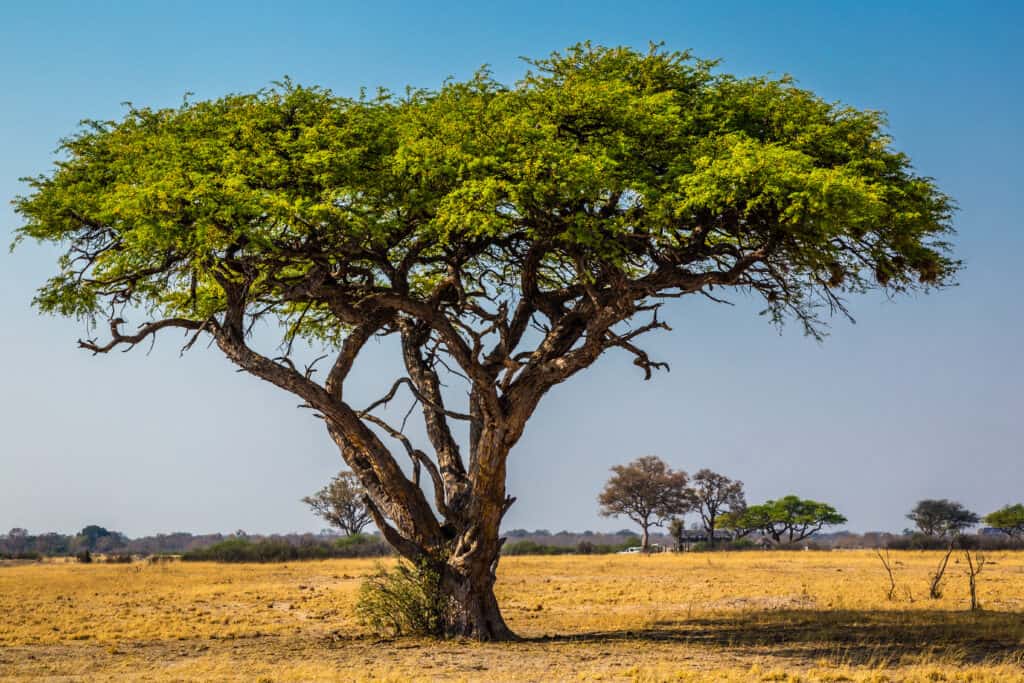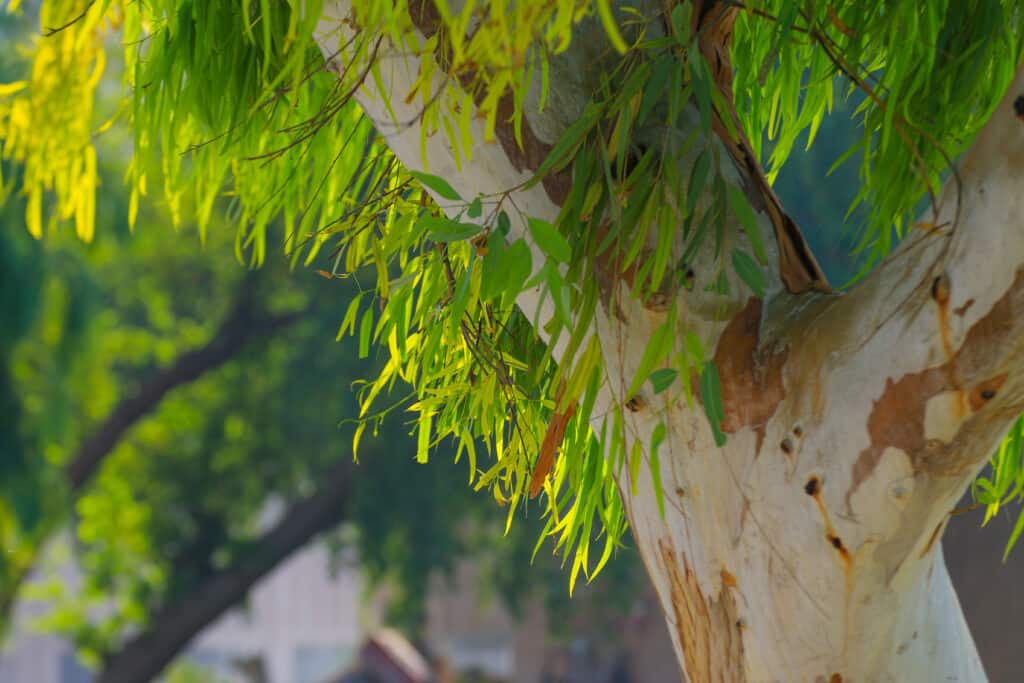Acacia and Eucalyptus trees may grow in similar habitats but there are many key differences between the two desert trees. Acacia, commonly known as wattle, is notable for its shedding bark and fine feathery leaves. Eucalyptus, known as the gum tree, emits a distinctive citrusy aroma from flat round leaves. Eucalyptus thrives as an indoor plant and can grow up to 6.5 feet a year. Acacia trees are iconic sights on the African Savannah or deep in the Australian bush.
What are some other differences between acacia and eucalyptus? Let’s take a look!
| Acacia | Eucalyptus | |
|---|---|---|
| Plant Classification | Acacia myrtaceae, 950+ subspecies | Eucalypteae, 700+ subspecies |
| Description | Evergreen trees which reach between 6 feet and 15 feet tall. A fast growing, thorny shrub with many uses in the garden, acacia is known for its long, feathery, fern-like leaves that grow up to 12 inches and globular clusters of fragrant yellow or white flowers. | Native to Australia, eucalyptus is a flowering tree or shrub cultivated for its fast growing and valuable timber crop. Mature eucalyptus trees are towering in height with downward facing leaves. Flowers range from white, cream, yellow, pink and red. |
| Uses | Acacia is grown for its hard wearing, orange-toned timber, used in furniture, flooring and in construction. Acacia gum harvested from sap is used in healthcare for its demulcent qualities and in topical treatments to help wounds heal. Many traditional applications exist from toothache to indigestion and diarrhoea relief. | Grown for shade, oils and bark, eucalyptus has many uses. Eucalyptus oil is a popular essential oil extracted from its leaves and employed to soothe nasal congestion, to add perfume to various cosmetic products and to repel insects. |
| Origin | Acacia is native to Australia and Africa and grows well in southern states of the US. Most prosperous in full sunlight and sandy soil, its large leafy canopy is a common sight in the desert. Feathery leaves can appear dark green or brown to slight silver blue or grey. | The oldest fossils of eucalyptus are found in South America where the tree is no longer native. A small number of subspecies are found in Indonesia and New Guinea and even as far north as the Philippines. |
| Special Features | Acacia hard wood has natural water-resistant properties making it an excellent choice for construction, especially building hulls on ships. | As Australian natives, Eucalyptus trees have evolved to cope with seasonal wildfires and have adapted mechanisms to resprout after vegetative bushfire. Some species of eucalyptus have evolved seedpods that survive fire! |
Acacia vs. Eucalyptus Description
Acacia, also known as wattle, has small pinnate leaves along the leaflets, creating a leaf structure resembling a comb. Sharp thorns protrude from the stems to protect the plant from destruction by herbivores. The bark on acacia trees is dark brown and furrowed. Acacia has a mature height of between 20 and 50 feet.

Acacia trees in have an average lifespan of 15-30 years — much shorter than many trees.
©LizCoughlan/Shutterstock.com
Eucalyptus, also known as the gum tree, can vary in size from a short bush to a towering tree. Young leaves are round and stemless, adult leaves appear blueish green. They are longer, stalked and hang downwards. The eucalyptus tree can reach 32 feet tall.
Acacia Fruit vs. Eucalyptus Fruit: What Is The Difference?
Acacia is a member of the pea family, and the fruit pods resemble pea pods. They appear long, straight or coiled. The pods, which grow in large black clusters, may be smooth or covered in fuzzy fine hairs and contain small seeds similar to peas and other legumes. Seeds are edible, protein rich and may be ground for flour or eaten as paste. Owing to the durable shell, acacia seeds are shelf stable and store well.
Eucalyptus seeds by comparison are encapsulated in a woody outer shell known as a gumnut. Seeds are waxy, conically shaped, approximately 1mm in length and can take months to ripen. Eucalyptus seeds are inedible and even toxic.

Eucalyptus trees thrive in warm climates.
©Aslam 360/Shutterstock.com
Acacia Flowers vs. Eucalyptus Flowers: How To Tell Which Is Which
The acacia is the national flower of Australia. Acacia flowers consist of five petals that come together to form a narrow star shape. The numerous long stamens give the fluffy ball-like appearance to the flower which ranges in color from bright white to dark red.
Eucalyptus flowers produce copious nectar to support a variety of pollinators including insects, butterflies, birds, bats, and possum. Interestingly, the flowers have no petals, instead a cluster of colorful showy stamens enclosed in a cap known as the operculum and resembling a dandelion flower droop downwards from the stem. Acacia flowers do not actually produce nectar. Its leaves secrete the sweet nectar to attract pollinators instead.
Acacia vs. Eucalyptus: Special Features
Acacias special feature is its timber. Strong, resilient, and orange hued, acacia wood is prized for its unique grain pattern. The durable, beautiful hardwood is suitable for commercial construction, design, and décor. The acacia tree regrows quickly meaning this renewable resource is in high demand.
Eucalyptus shed their bark annually, exposing a red gummy resin which is harvested for medicinal use like lozenges and dental care. Eucalyptus has antimicrobial and antifungal properties. The round, coin shaped leaves of the eucalyptus tree are fragrant and often found in floral arrangements.
How To Grow: Acacia vs. Eucalyptus
Acacia prefers desert and tropical climates, but as a fast growing and diverse species, they may become invasive. They grow quickly and produce brittle branches which break easily. They grow best in well drained sandy soil. As a result of evolution acacia seeds are impervious to water, requiring scarification or heat treatment prior to germination.
Eucalyptus trees thrive in warm climates. Adapted to life in Australia where soil can be thin and leached of nutrients, they have developed spreading roots with up to 90% of the root system found in the top 12 inches of soil. This shallow root system may lead to wind and weather damage. Cultivated crops of eucalyptus grown in deep rich soil grow faster and taller than wild species.
Acacia vs. Eucalyptus: What Products Derive From Each Tree
Acacia bark produces gum Arabic, a resinous substance used in pharmaceuticals, traditional medicines, inks, soda, and food manufacture. Acacia contains naturally occurring tannins, used as an emulsifier in cooking and to dye cloth.
Eucalyptus leaves produce essential oils, used in aromatherapy, perfumes and cosmetics. Leaves are dried, added to potpourri and used to purify and perfume air. Timber is harvested for building and pulp for paper making.
Acacia vs. Eucalyptus: Which Produces Honey?
You may see acacia honey for sale at the market, but this substance is not from the acacia tree. It originates from the fake acacia, also known as the black locust tree, and due to its high fructose count, is one of the clearest honeys available.
Eucalyptus honey, often cultivated in California, is a sticky sweet herbal syrup with a slight menthol aroma. Although a new ingredient to the market, its antiseptic and anti-germicidal properties along with its natural golden color make it a popular choice for baking.
Acacia vs. Eucalyptus: Did You Know?
Beneath the thorny stems of the acacia tree, colonies of ants make their nests. In return for the protection the thorns offer, the ants take care of any harmful bacteria or leaf eating insects that may attack the acacia. The ants symbiotically carry acacia seeds deep underground to safely plant the next generation of acacias. The eucalyptus tree may play an important part in pollution control. Not only do the root systems retain more water than usual which may prevent groundwater flooding, it captures airborne particles from our atmosphere, retaining them on the leaves until rain washes the particles away. However, fire travels easily through eucalyptus trees dues to the high level of oils present in their leaves, making them unsuitable for large plantations.
Acacia vs. Eucalyptus Facts
- Acacia flowers are harvested for use in perfume and cosmetics industries.
- The Australia mountain ash eucalyptus is the tallest of all known flowering plants, measuring up to 100 metres high!
- Acacia leaves are an important foodstuff for goats, cattle, and giraffe.
- In spite of having no petals, eucalyptus flowers are the most distinguishable part of the plant, with copious fuzzy stamens in an enclosed operculum.
- Tannins, a dark sticky substance derived from acacia bark, are used to tan leather.
- The name eucalyptus comes from the Greek words for “well-covered,” referring to the tight operculum.
- Most acacia have a short life span for a tree, living just 15-30 years.
- Kino is the name for the botanical gum produced by the eucalyptus tree.
- Gum Arabic procured from acacia was used as a thickener in cosmetics, makeup, and paint as far back as Ancient Egypt!
Acacia vs. Eucalyptus: Overview
Two distinct plant species with different characteristics, acacia and eucalyptus do share one thing in common: habitat. Both are also useful crops to cultivate and harvest and valuable additions to the landscape, providing shade and shelter to insects, animals and birds.
Whether wattle or gumtree, through deep rooted flood control and food for livestock, both acacia and eucalyptus enrich and improve the environment they thrive in.
Up Next:
- What Do Giraffes Eat? Their Diet Explained
- Koala Poop: Everything You’ve Ever Wanted to Know
- What Scent Will Keep Rats Away?
The photo featured at the top of this post is © LizCoughlan/Shutterstock.com
Sources
- Brittanica, Available here: https://www.britannica.com/plant/acacia
- Fair Harvest, Available here: https://www.fairharvest.com.au/mature-eucalypyus-and-acacia-in-a-permaculture-system/
- Medical News Today, Available here: https://www.medicalnewstoday.com/articles/266580
Thank you for reading! Have some feedback for us? Contact the AZ Animals editorial team.







